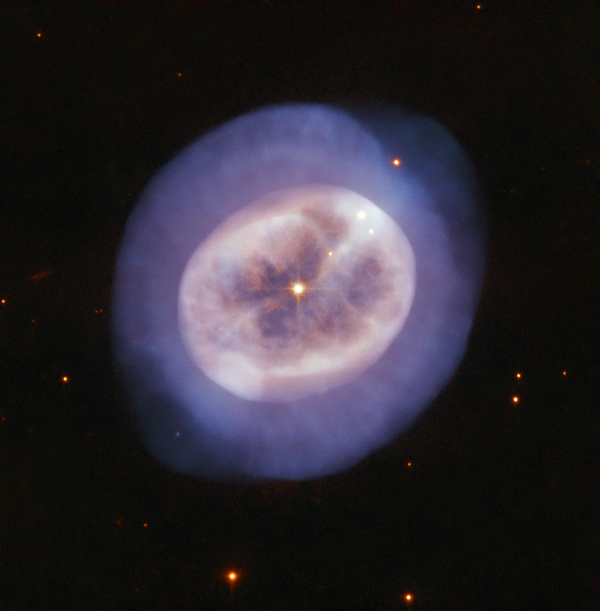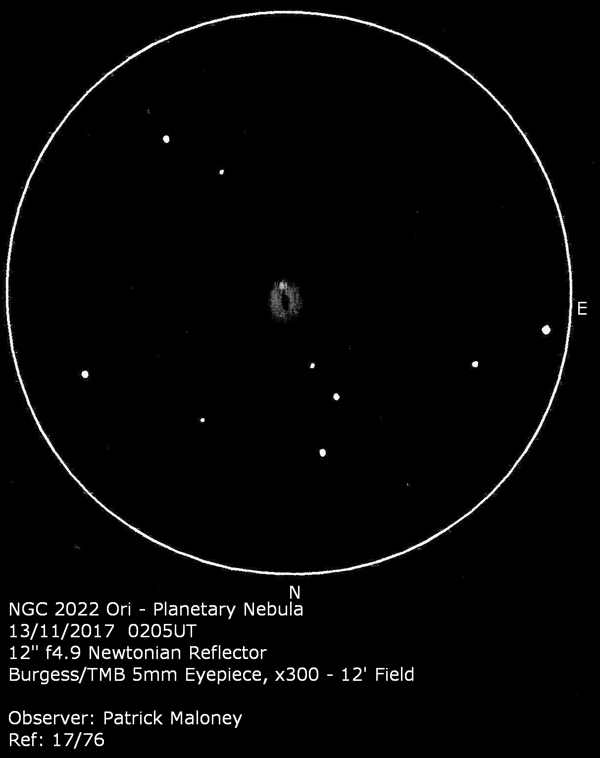NGC 2022 in Orion
December 2023 - Nebula and Cluster of the Month
As we move towards midwinter, the skies are becoming dominated by the brilliant winter constellations. Orion, the unpleasant anti-hero of last month’s feature, culminates at about midnight during December. Orion lies close to the Milky Way and as such is host to a number of fine examples of nebulae and clusters.
Lying ⅔ of the way between α Orionis (Betelgeuse) and λ Orionis (the top star in the little triangle that forms Orion’s beard) lies a planetary nebula, NGC 2022.
It was first seen by William Herschel on the night of 28 December 1785. At that time, he described it as Considerably bright. Small. Nearly round, like a star with a large diameter. With 240 (magnification) like an ill-defined planetary nebula.
He entered it in his catalogue in the fourth class (planetary nebulae) as no. 34.

NGC 2022 is an example of a multiple-shell planetary nebula. The inner shell is the brightest and spans about 18”. A fainter shell surrounds this and extends to a diameter of around 40”. Recently reported (September 2023)1 is the discovery of a faint outer halo, reaching a diameter of 88”. The authors of this paper also made a determination of the planetary nebula’s mass – 0.9 solar masses, of which 0.64 solar masses reside within the central star.
The magnitude of NGC 2022 is widely given as 11.9 visual, slightly fainter photographically as 12.4. The central star is a difficult object, often quoted as magnitude 14.9, sometimes as 15.9. The nebula is elliptical, the inner shell measuring 21.4” by 16.7”. The outer shell has the same proportions. The classification (according to the Vorontsov-Velyaminov system) is IV+II, meaning there is an annular (ring-like) structure within a smooth disc.
The amount of detail visible to the eye in the nebula depends quite heavily on the size of telescope employed. I have often looked at this object, and have two drawings in my files, made with similar telescopes (both were 12” Newtonian reflectors), but made with different magnifications.

The first observation, made in February 1996, says this: Very bright and clear. Small and round. It appeared very smooth. The brightness increases evenly towards the centre. High power revealed a slight suggestion of elongation.
This observation was made with a magnification of x81.

The second observation, made in November 2017, says this: Pretty bright. Slightly elongated and darker in the middle. There is also a dim outer disc of nebulosity. A brighter spot can be seen to the south. There is no sign of a central star. The UHC filter enhances the internal structure, but the OIII filter doesn't help. It appears grey in colour to me.
This observation was made with a magnification of x300.
Note that with the higher magnification, the elongation is clear, the annularity can be seen, and the fainter second shell is also visible, albeit faintly. When observing planetary nebulae, it pays (probably more than with any other type of deep-sky object) to play around with different magnifications. I have found in several cases that a planetary nebula visible at medium powers only with an OIII filter in place becomes quite clear without the filter at high magnifications.
The colour of planetary nebulae is another aspect well worth noting. Planetary nebulae are typically green or blue (with the odd red outlier). Fainter planetary nebulae almost always appear grey. The Night Sky Observer’s Guide, Vol. 1, reports that with an 8-10” telescope, the colour of NGC 2022 is greyish, whereas with a 12-14” instrument, it is slightly greenish in tint
. I have personally never seen the disc as anything but grey.
May I take this opportunity to wish you all a very merry Christmas, or whatever way in which you may celebrate midwinter.
| Object | RA | Dec | Type | Magnitude |
|---|---|---|---|---|
| NGC 2022 | 05h 42m 06s | +09° 05’ 10” | Planetary nebula | 11.9 |
References:
- NGC 2022, a case study of a multiple-shell planetary nebula - B Montoro-Molina et al, MNRAS 524, 2, September 2023